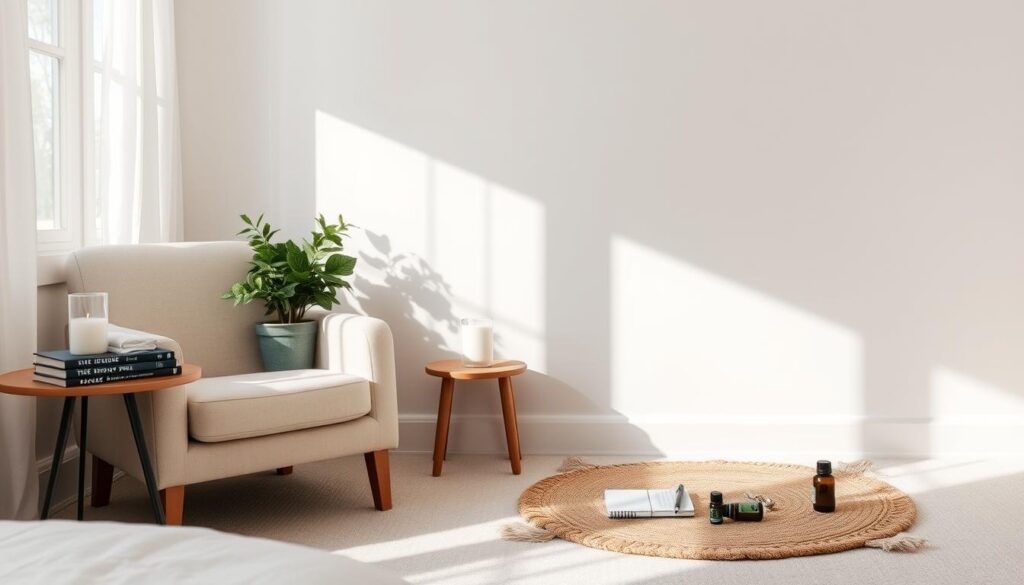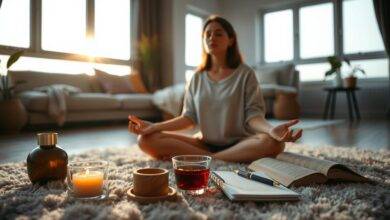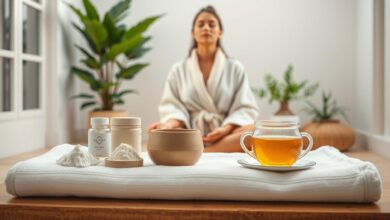Refresh and Renew: Self-Care Activities to Try at Home

Life can feel like a never-ending list of tasks, with screens and responsibilities everywhere. It’s easy to forget to take a break and care for ourselves. But, what if you could practice self-care right in your own home? It doesn’t have to be hard or expensive.
These small moments of care can turn your home into a peaceful place. They remind you that taking time for yourself is not selfish. It’s necessary.
This article will show you how to find peace in your own home. It doesn’t matter how busy or small your life feels right now.
Key Takeaways
- Self-care at home builds resilience against daily stress.
- Even small actions like lighting candles or stretching count as meaningful self care practices at home.
- Home-based routines create consistency without requiring time or money.
- Self-care strengthens mental and physical health over time.
- Everyone deserves to prioritize their well-being in simple, accessible ways.
Understanding the Importance of Self-Care
Self-care is more than just a trend—it’s essential for our well-being. This guide explains what self-care means, backed by science and easy steps for everyone.
What is Self-Care?
Self-care means taking steps to care for your body, mind, and spirit. It’s not about fancy spa days. It’s about simple, daily habits like:
- Walking in nature
- Deep breathing exercises
- Journaling thoughts
Benefits of Practicing Self-Care
Studies show self-care can cut stress hormones by up to 30%. It boosts energy, focus, and strengthens your immune system. A 2023 study found self-care routines lead to better sleep and emotional strength.
Common Misconceptions about Self-Care
“Self-care isn’t selfish—it’s essential.”
Many think self-care costs a lot or takes too much time. But, small actions like enjoying a cup of tea or stretching are valuable. Even 10 minutes of deep breathing is enough. Everyone’s self-care looks different—it’s all about what works for you.
Creating a Cozy Atmosphere at Home
Turning your home into a peaceful place starts with small steps. Self care activities at home become more enjoyable when your space feels calm and inviting. Here’s how to make a space that cares for your body and mind.
Choosing the Right Lighting
Lighting can greatly affect your mood for self care activities for relaxation. Soft, warm bulbs (2700-3000K) help reduce eye strain and make you feel relaxed. Here are some ideas:
- Dimmable floor lamps for cozy reading spots
- Candlelight (use soy or beeswax for safety) in baths
- String lights draped over bookshelves or windows
Aromatherapy Essentials
Scents can quickly change your mood. This table lists top oil blends and their benefits:
| Oil | Best For |
|---|---|
| Lavender | Stress relief |
| Lemon | Energy boosts |
| Peppermint | Mental clarity |
Use diffusers, spray mists, or even a jar of dried rosemary to add therapeutic scents to your space.
Comfortable Furnishings
Choose seating that feels like a hug. Add a memory foam throw pillow to a wicker chair by the window. Clear surfaces to clear your mind—try these quick tips:
- Roll out a yoga mat for floor seating
- Layer blankets in neutral tones
- Use storage baskets to hide clutter
A cozy corner with these elements can turn any room into your own retreat. Even small changes can make your home a place for daily self-care.
Engaging in Mindful Meditation Practices
Meditation turns quiet moments into self care activities for mindfulness. Even a short time can help you stay present, reduce stress, and bring calm. Begin with just one minute a day and increase it as you feel comfortable.
Quick Meditation Techniques
Try these easy ways to clear your mind:
- Body scan: Close your eyes and mentally scan from toes to head, noticing sensations without judgment
- Breath awareness: Focus on inhale/exhale patterns for 2-3 minutes during breaks
- Loving-kindness meditation: Repeat phrases like “May I be safe” to cultivate self-compassion
Apps for Guided Meditation
These apps offer structure and variety:
| App | Features | Best For |
|---|---|---|
| Headspace | Guided sessions for anxiety, sleep, and focus | Newcomers needing structured guidance |
| Calm | Sleep stories, breathing programs, and masterclasses | Stress relief through nature sounds and visualizations |
| Insight Timer | Free access to 100,000+ guided meditations | Exploring diverse practices without cost |
Setting Up a Meditation Space
Create a peaceful spot even in small areas:
- Designate a corner with a folded blanket or yoga mat
- Add soft lighting with battery-operated candles
- Use noise-canceling headphones to block distractions
Being consistent is more important than being perfect. Adapt these self care activities for stress relief to your life. Progress comes from regular practice, not perfect sessions.
Exploring Creative Outlets for Relaxation
Doing creative self care can turn simple moments into chances for healing. Activities like crafting, journaling, or art calm the mind and boost emotional wellbeing. Let’s see how creativity leads to inner peace.

“Creativity is a form of therapy that requires no prescription.” – Unknown
Begin with small steps to make it a habit. Here are some ideas:
Crafting and DIY Projects
- Origami: Fold paper cranes for mindful focus.
- Knitting: Make scarves or dishcloths with easy patterns.
- Upcycling: Make candle holders from old jars or quilts from fabric scraps.
Journaling for Reflection
Use prompts like “What emotion do I need to release today?” or color-code your mood. Try writing letters to process feelings without sending them.
Painting and Drawing
It’s okay if your art isn’t perfect! Use watercolors for abstract art or draw mandalas with your hands. Even doodling during calls is a form of mindful art.
| Activity | Key Benefits | Quick Start Ideas |
|---|---|---|
| Crafting | Hand-eye coordination, focus | Recycled paper collages |
| Journaling | Emotional clarity | Emotion scales (1-10) |
| Art | Mindfulness | 5-minute doodle challenges |
Remember, creativity is about showing up, not perfection. Even 10 minutes of sketching or writing can refresh your mind. These activities turn blank pages into healing canvases. Let curiosity lead you, not the outcome.
Physical Self-Care: Simple Home Exercises
Move your body with joy—these self care activities for physical health turn exercise into moments of empowerment. Start small: even 10 minutes of mindful movement can uplift your energy and mood. Whether you’re a beginner or looking for variety, these ideas blend fun and fitness seamlessly into daily life.
Begin with yoga flows that need no mat or expertise. Try “cat-cow” to ease back tension or “child’s pose” to reset after work. YouTube channels like Yoga with Adriene offer free guides for all skill levels, making it easy to follow along. No equipment? No problem—these stretches use gravity and breath to build strength.
Turn up the music for a dance break! A 5-minute living room party to upbeat tunes like “Shake It Off” or salsa rhythms can boost serotonin. Pair dance with family movie nights or solo work breaks—movement here is a mood lifter, not a chore. Apps like Spotify offer curated workout playlists to match your vibe.
Combat stiffness with targeted stretches. For desk workers: roll shoulders backward 10 times to release tension. Before bed, try a forward fold to calm your nervous system. Focus on how each motion feels—lighter, stronger, more alive—instead of comparing to others.
Incorporate “movement snacks”: a quick walk around the house during calls, calf raises while waiting for coffee. These tiny bursts add up, proving self care practices at home don’t require hours. Let your body guide you—rest when tired, move when ready. Every step honors your needs.
Nurturing Your Body with Healthy Eating
Self care starts with nourishing meals that fuel your body and soul. A balanced diet isn’t about cutting out food. It’s about making choices that support your well-being. These ideas make healthy eating easy and fun, even when you’re busy.
Meal Prep Ideas for Busy Days
Meal prep can turn chaos into calm. Here are some tips:
- Batch-cook proteins (chicken, beans, tofu) on Sundays
- Pre-chop veggies for quick stir-fries or salads
- Store portioned meals in clear containers to visualize options
| Component | Examples |
|---|---|
| Proteins | Grilled chicken, lentils, tofu |
| Veggies | Roasted broccoli, spinach, bell peppers |
| Grains | Quinoa, brown rice, farro |
Comfort Foods with a Healthy Twist
Enjoy your favorite foods without the guilt. Try these swaps:
- Swap white pasta for zucchini noodles in lasagna
- Add pureed cauliflower to mashed potatoes
- Use dark chocolate (70%+) in homemade protein balls
The Importance of Hydration
Drinking enough water boosts energy and focus. Here’s how to stay hydrated:
- Infuse water with cucumber, lemon, or berries
- Track intake with apps like Plant Nanny or Hydrate
- Pair water with herbal teas for variety
Your body does best when you eat foods you love and that are good for you. Making small changes can lead to lasting habits that honor your body and satisfy your cravings.
Unplugging from Technology
Technology makes life easier, but too much can wear us down. Taking breaks from tech is a key self care activity for stress relief. It lets us focus on what’s important. Start by setting clear times for being online and offline.
Setting Boundaries on Screen Time
- Use built-in tools like iPhone’s Screen Time or Android Digital Wellbeing to track and limit app usage
- Designate tech-free zones (e.g., the bedroom) and times (e.g., mealtimes)
- Share scripts like, “I’m turning off work notifications after 7 PM—let’s chat in person!” to set expectations
Ideas for Offline Activities
Swap screen time for real-life experiences that excite your senses:
- Rediscover physical books or magazines for immersive reading
- Host a board game tournament with family or roommates
- Practice mindful gardening or cooking—activities requiring full attention
Benefits of Being Present
“Focusing on one task at a time strengthens neural pathways for sustained attention,” explains Dr. Jane Lee, a cognitive psychologist.
Less digital multitasking means more creativity and better emotional control. Even 15 minutes of self care activities for mindfulness like stargazing or journaling can refresh your mind. Make being present a priority to fight the feeling of being overwhelmed by endless digital noise.
Establishing a Self-Care Routine
Starting a self-care routine at home is all about small steps. These routines fit into your life, not the other way around. Start with habits that feel natural, not forced.
Morning Rituals to Start Your Day
Find a morning practice that works for you:
- 5-minute: 5 breaths + hydrate + set one daily intention
- 15-minute: Add a short stretch sequence (try yoga apps like Down Dog)
- 30-minute: Combine meditation, journaling, and a nourishing breakfast

Evening Wind-Down Activities
Get ready for sleep with these steps:
- Power down screens 1 hour before bed (use blue light filters if needed)
- Try a 10-minute guided body scan meditation
- Lower room temperature to 65-68°F to optimize rest
Weekly Self-Care Challenges
Try new things slowly:
- Day 1-3: Add 5 minutes of mindful breathing post-dinner
- Day 4-7: Try a new creative self care practice (painting, pottery, or gardening)
- Day 8-10: Schedule a weekly check-in with a friend
“Routine without flexibility becomes a cage. Routine with flexibility becomes a compass.”
Make new habits part of your daily life. Add a deep breath before checking email, or stretch while waiting for coffee. When habits feel like choices, not chores, consistency grows.
Building Your Support Network
Healthy relationships are key to self care for mental health. Building a support network means investing in emotional resources that help you thrive. Start by prioritizing connections that energize you.
Reach Out with Purpose
Start self care activities for emotional wellbeing by initiating conversations. Use simple scripts like: “I’d love to hear how you’re doing. Can we chat this week?”. Set boundaries by saying, “I need 15 minutes to process this.” Choose people who listen without judgment.
- Text a friend: “Wanna share a coffee and vent?”
- Join online forums like 7 Cups or Rainreach for shared challenges
- Attend in-person events via Meetup.com or community center bulletins
Virtual Spaces That Nourish
Search for groups aligned with your goals. Ask: Does this space lift me up? Platforms like Facebook Groups and Wellio host communities for parenting, grief, or career shifts. Prioritize spaces with active moderation and positive vibes.
Explore Local Resources
Local libraries, YMCAs, and faith-based organizations often host free workshops. Try:
- Volunteer at a food bank to build connections
- Take a pottery class at a community center
- Visit NAMI (National Alliance on Mental Illness) for in-person support
“We grow through others.” – Aristotle
Self care isn’t just solo activities—it’s about choosing relationships that sustain you. Mix virtual and local options to create a balanced support system.
Reflecting on Your Self-Care Journey
Every self-care journey is a work in progress. As you explore different self care routine ideas, reflection helps turn one-time practices into habits. These habits truly nurture your well-being. Taking time to evaluate your experiences ensures your efforts align with your unique needs.
Keeping a Self-Care Journal
Use a notebook or apps like Day One to track how activities like yoga or journaling impact your mood. Note moments of calm or renewed energy—this creates a roadmap of effective self care tips for mental health. Ask yourself: Which practices leave you feeling restored?
Evaluating What Works for You
Check in weekly to assess three factors: energy spent, engagement, and results. Does that morning walk invigorate you, or does it feel like a chore? Adjust routines based on honest answers, not what others recommend.
Setting Goals for Personal Growth
Goals should grow from your values, not external pressure. If quiet time matters, aim for 10 minutes of meditation daily. Prioritize small steps that feel meaningful, not overwhelming.
Self-care isn’t fixed—it shifts with life’s changes. Celebrate progress, and stay open to trying new methods. The best routines adapt as you do, ensuring your mental health stays a priority. Trust your insights, and let curiosity guide your next steps.




